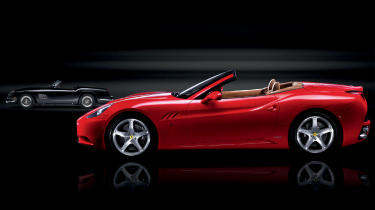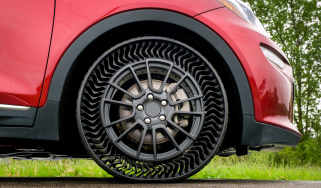Ferrari California in depth: A different sort of Ferrari
Front-mounted V8, dual-clutch transmission, folding hard-top – and styling that divides opinion like few others
Ferrari's California embodies a number of radical and significant developments for the Italian marque. First and foremost it is the first V8-engined Ferrari road car to place the engine in front of the driver. Secondly, it is clearly aimed at new customers, the type who currently buy Mercedes’ high-powered SL models and Aston’s DB9. Which suggests that Ferrari’s annual production figures are set to soar; in fact a new factory is currently being built at Maranello.
The California also has two completely new features for any Ferrari production car – a DSG-style twin-clutch transmission, and a folding hard-top which disappears into the slightly bulbous rear quarters. Indeed the styling is one of the more controversial aspects of the car, seemingly dividing opinion like few other Ferraris in memory. And finally it resurrects a name that hasn’t been seen on a model from Maranello for more than 40 years.
Look back through Ferrari history and the name ‘California’ first crops up in the late 1950s and early 1960s when a number of limited-run convertibles were built for wealthy American enthusiasts around the chassis and V12 engine of Ferrari’s fabulous 250GT Tour de France production street-racer. Over the next few years, the California tag came to stand for the ultimate, driver-focused convertible Ferrari.
The decision to introduce a front-engined V8 model was taken by Luca di Montezemolo some four years ago in response to customers who found the mid-engined F430 too compromised for daily use compared with front-engined rivals. From now on there will be two distinct branches of the Ferrari family: on one side the ‘prestige sporty GTs’ which will include the California and the 612 Scaglietti, and on the other the more extreme sporting models, which will include F430 and Scuderia, 599 GTB and the eventual Enzo replacement.
Mechanically, the California is dramatically different to any current Ferrari. It’s powered by a heavily reworked version of the F430’s 4308cc V8. It retains the flat-plane crankshaft but it introduces direct fuel injection (a first for Ferrari – see panel overleaf) and it’s tuned to deliver a broad spread of torque, rather than a spiky power-peak, although 454bhp at 7500rpm is hardly shabby for a 4.3-litre engine.
The V8 drives the rear wheels via a transaxle transmission with a brand new, seven-speed dual-clutch gearbox (see over for details), mounted in unit with the rear differential casing, helping to give the car an ideal, slightly rearward weight bias to enhance handling and traction. Ferrari says the feel of the gearchanges will be more aggressive than we’re used to from dual-clutch transmissions (especially those offered by VW and Audi) because that’s what Ferrari customers expect and want. Brembo has developed new carbon-ceramic brakes, which will be standard on the car, as will the latest F1-Trac traction control system first seen on the 599.Ferrari has also developed an all-new, multi-link rear suspension set-up, optimised to give the California excellent ride characteristics in keeping with its GT role. The car is ostensibly a 2+2, but appearances suggest the rear seats might be more suited to carrying golf clubs than even the smallest humans.
The only performance figure the factory is quoting is 0-100kph (62mph) in ‘less than 4.0sec’, which will be remarkable for a lavishly equipped convertible expected to tip the scales at around 1700kg. Ferrari has tried hard to keep the weight down – the bodywork and chassis are fabricated entirely in aluminium – but this is a relatively large car fitted with a powered folding hard-top, which brings its own weight penalty. For comparison, the Maserati GranTurismo weighs 1880kg, while the carbonfibre-bodied Alfa 8C comes in at 1585kg.
The California will also come with a pretty hefty price-tag. Sources inside Ferrari hint at a list price of around £150,000 before extras. But even at that price, judging by the reaction of potential customers (see far right) it’s going to sell by the thousand, which is precisely why Ferrari has been busy building a new assembly plant.
Quite how that squares with the frequent statements from Maranello that Ferrari production must be capped to retain the marque’s exclusivity remains to be seen. Ferrari’s annual production figures have been climbing every year since 1997 (3581) to hit a peak of 6465 in 2007, the first time it has broken the 6000 cars a year barrier. Some commentators are predicting that sales could hit 10,000 in a few years’ time. Back in 2006, when pressed over whether Ferrari would ever go beyond 6000 new car sales, Montezemolo told reporters: ‘We (Ferrari) will sell the same number of cars in each of our traditional markets but more in new markets; we need to maintain Ferrari’s exclusivity.’
The California will get its official unveiling at the Paris show in October, by which time the order book will already be bursting. Controversial looks or not, Ferrari seems to have another massive success on its hands.
New 4.3-litre V8 engineAlthough similar to the F430’s 4.3-litre V8, the new version in the California features Gazoline Direct Injection (GDI), a Ferrari first.
Why GDI? Squirting fuel directly into the combustion chamber gives much more accurate control, reducing waste and improving emissions, ergo better mpg and lower CO2. In regular injected engines, the petrol has a nasty habit of sloshing around the inlet port and falling out of suspension as the air pressure goes up, so when you suddenly floor the throttle a great lump of fuel lands in the cylinder but won’t burn properly.
But surprisingly GDI also effectively raises the fuel’s octane rating because only air is sucked in through the inlet valve (slightly more air than in a non-GDI engine because the fuel is not taking up space) and heated up by compression. The fuel is not being heated so has a cooling effect when injected, allowing higher compression ratios to be run without pinking, so performance is significantly improved.
There are down sides. Higher revs need higher fuel pressures to get all the fuel in before the spark.Mechanical pumps running up to 200bar can be noisy, while using off-the-shelf injectors can be a limiting factor; little time for the fuel to mix with air leads to clumping and higher smoke/soot generation, affecting oil life and cylinder wear. Ferrari quotes the peak power of the new 4.3 V8 at 7500rpm, compared with 8500rpm for the F430 engine, which may be down to the injectors. Still, at 7500rpm, the power is higher than in the F430 at that same speed, promising improved acceleration throughout the available rev-range. Ralph Hosier
Dual clutch transmissionThe seven-speed Dual Clutch Transmission (DCT) is another Ferrari first for the California and, ideally for a GT car, promises drivers the best of both worlds: the convenience and smoothness of an automatic and, at the press of a button, the aggression and shift speed of Ferrari’s ‘F1’ automated manual transmission (AMT).
Ferrari’s technical partner on the new transmission is Getrag-Ford, the company that helped create BMW’s M-DCT, recently launched in the M3 Convertible (see page 66). Insiders say that development of the Ferrari DCT has taken much longer than anticipated (it was originally scheduled to appear in the 612 Scaglietti).
The adoption of the DCT is almost entirely positive. It can behave like a conventional auto but is more economical and will be untroubled by stop/start city driving, unlike an AMT which can wear out its clutch plate rapidly. Then, at a twist of the steering wheel ‘manettino’, the DCT can become as sporty as F1 Superfast, offering shifts with minimal torque interruption which, in league with seven ratios, will offer better acceleration than the six-speed F1 box.
The only downside is that the DCT is about 10kg heavier than the F1 AMT, but this is turned to an advantage by the California’s transaxle layout. The front-mid-mounted V8 is connected to the transaxle via a torque tube, with the gearbox on the far side of the rear axle line, helping weight distribution. Like DCTs in transverse engine/front-drive applications, the Ferrari unit is a compact three-shaft design – good packaging in the tail of the California is crucial with a folding hard-top to accommodate. John Barker
California: Hit or miss?
The designerPeter Stevens, Professor, Vehicle Design, RCA‘It’s a strange mix of TVR and Lexus, while that line down its flanks is staggeringly bad. Just because it’s red and has that badge we shouldn’t excuse it. It’s just not good enough.’
The dealerTom Hartley, prestige car dealer‘Ferrari is the strongest brand out there. They have the best vision of what people want, so it’s an unbeatable combination. It’ll be a massive hit.’
The businessmanNick Hancock, Segrave Club‘Despite all the gloom at the moment this car ticks so many boxes it can’t fail to be a huge success. The long waiting list will mean mega residuals too.’



